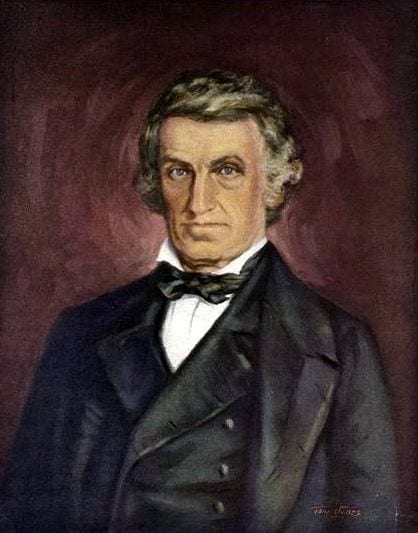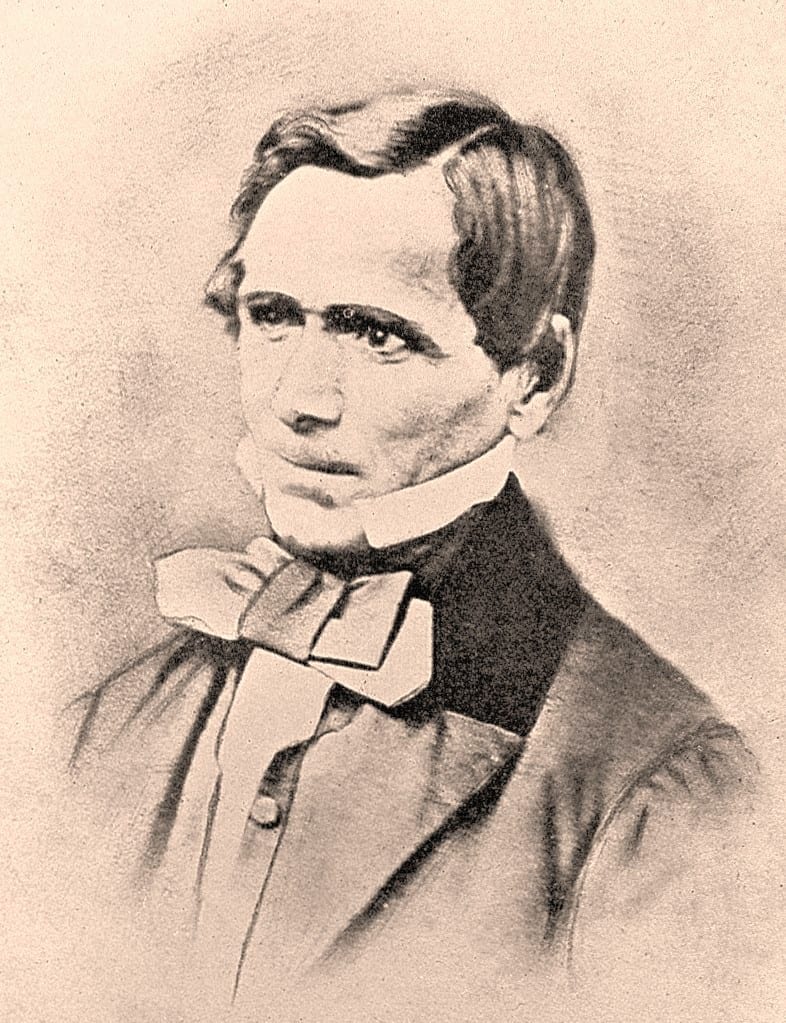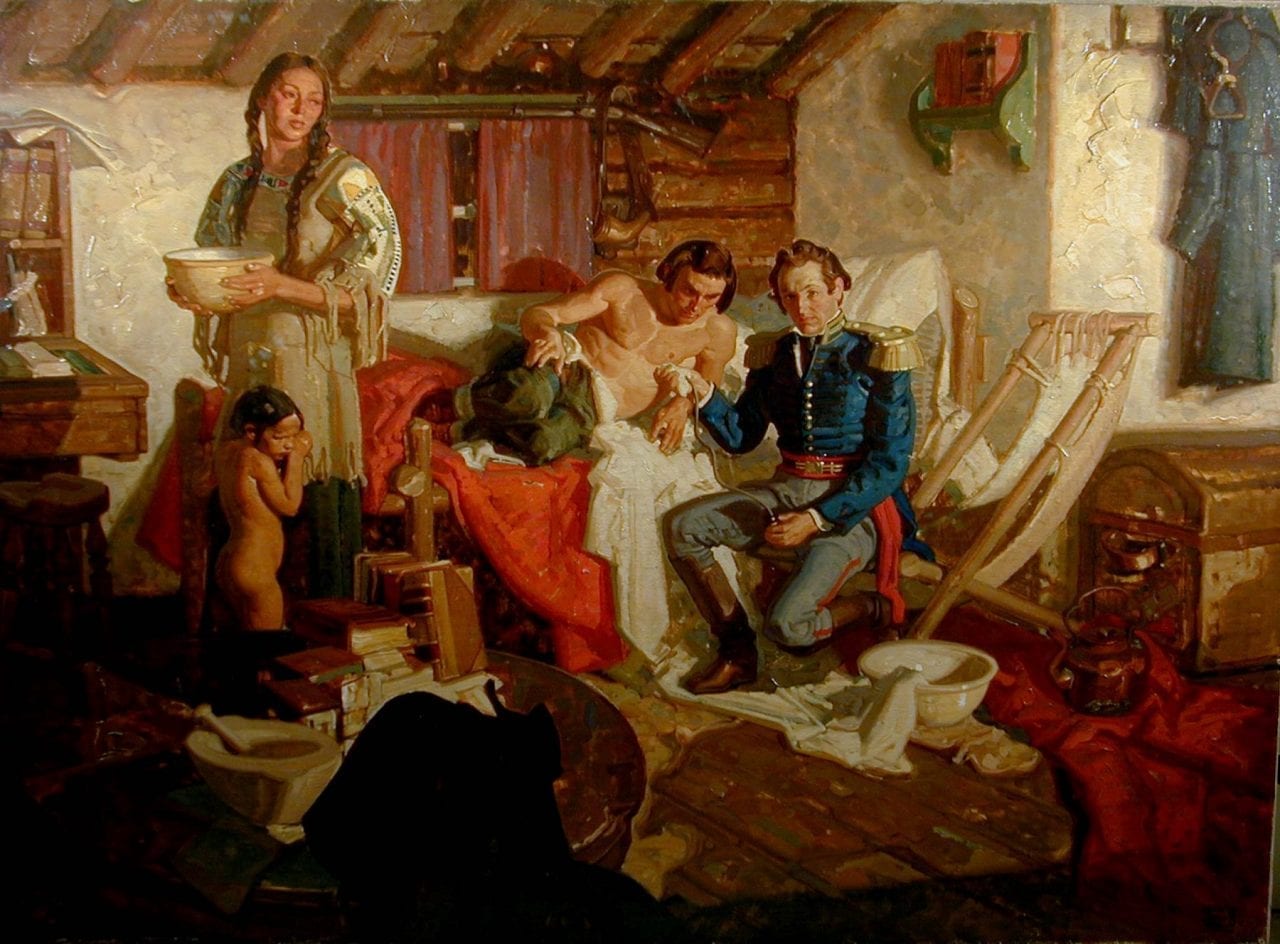The picturesque island of Mackinac lies three miles off the coast of Michigan, at the junction of Lakes Huron and Michigan. It is a favorite resort where tourists can admire old French-style buildings with tall slated roofs, ride in open carriages pulled by horses that know when to turn or stop, and stay at the famous Grand Hotel with the swimming pool named after Esther Williams of the 1947 film This Time for Keeps. The romantic classic Somewhere in Time was filmed there in 1980; and also on the island stands a statue of William Beaumont, whom Sir William Osler called “the pioneer physiologist of this country, the first to make an important and enduring contribution to the science.”
William Beaumont descended from an old family whose ancestors crossed over to England with William the Conqueror or later when Louis XIV drove out the Huguenots. An earlier Beaumont came to New England, America in 1635, and a later one moved the family to Lebanon, Connecticut, and became a successful farmer. William Beaumont was born there in 1785. At the age of twenty he aspired to something greater then farming and left to teach school in the small village of Champlain, New York, near the Canadian border. Inspired by reading the medical books of a local physician, he decided on a career in medicine and became a pupil of Dr. Benjamin Chandler of St. Albans. There in return for sweeping the house and keeping the medicine bottles clean, he learned to prepare powders, make pills, assist at operations, cup and bleed and amputate, diagnose diseases, and write prescriptions. On finishing his apprenticeship, he was licensed to practice by the state of Vermont and at the outbreak of the 1812 war with England enlisted in the army. He gained much practical experience, and after the war settled in Plattsburgh, New York, where he married and established a general practice. In 1820 he re-entered army service and was assigned to the frontier post of Fort Mackinac.
It was there that in June 1822 a gun went off accidentally, shooting Alexis St. Martin, a young Canadian fur trapper who was standing not more than three feet away. The bullet rent a hole the size of a man’s hand, fractured the fifth and sixth rib, lacerated the left lobe of the lungs, and perforated the diaphragm and stomach. Beaumont saw the patient within half an hour of the accident. He found two large protrusions, one “as large as the turkey’s egg” of the lung, the other of the stomach. The protruding lung was particularly troublesome because it allowed the free escape of air and blood at every respiration; and pushing it back required cutting out the sharp part of the broken rib. As food kept coming out from the damaged stomach, Beaumont maintained St. Martin by anal injections until he was able to push back the exteriorized part and allow oral feeding.
Beaumont applied “fermenting” poultices and gave oral medications with camphor “in liberal quantities.” The path to recovery proved stormy. St. Martin had bouts of fever, for which Beaumont bled him and administered a cathartic. He had difficulty in breathing and cough from the lung injury, sloughing of damaged tissue with abscess formation, and a purulent discharge. But in time healing and scarring took place. By one year after the accident St. Martin was able to walk, all was healed, but there remained an opening in the stomach about two inches in circumference. This required the constant application of bandages and compresses, but eventually a small fold of the lining of the stomach developed and formed a kind of a valve that prevented the escape of the stomach contents.
About eight months after the accident the Village of Mackinac decided it would no longer pay for the care of a foreign pauper and wished to send St. Martin to Montréal. Beaumont objected that the patient would not be able to withstand the long journey in an open boat and took him in his own house. There he remained for two years, doing household chores and helping Mrs. Beaumont, who was not accustomed to the rough life on the Frontier. By the fall of 1824 Beaumont realized that the case “affords an excellent opportunity for experimenting upon the gastric fluids and the process of digestion.” He communicated his findings to Surgeon General Joseph Lovell, who took much interest in the case and sent him books on gastric digestion. In August 1825, when Beaumont was reassigned to Fort Niagara, New York, he began his research by attaching food items to a string, suspending them in the cavity of the stomach and then pulling them out. He used beef, pork, stale bread, and red cabbage. He also withdrew gastric juice and suspended in it various kinds of food and found the food was largely digested. Concluding that digestion was achieved by the dissolving action of the gastric juice, he published his results in a medical journal in January 1826, but his experiments came to a sudden end when St. Martin “absconded” to Canada.
This subject of how the stomach digested food had long interested scientists, some like Sanctorius and Borelli believing in a grinding mechanical process, others favoring fermentation, putrefaction, or disintegration by heat. Digestion by a chemical reaction had been suggested by Van Helmont and Silvius, more recently by the Frenchman Reaumur and also by the Italian Lazarro Spalanzani, who swallowed sponges tied to strings and pulled them out, found they had been dissolved, but concluded that the gastric juice contained ammonia compounds and was neither acid nor alkaline but neutral. Several other investigators carried out experiments showing that gastric juice was acidic but could not agree on the nature of the acid. In 1824 William Prout in England published that hydrochloric acid was present in gastric juice but his conclusion was attacked by other scientists.
Beaumont did not see St, Martin for four years, until 1829, when while posted to Fort Crawford at Prairie du Chien, Michigan, he learned that St. Martin was living near Montréal, “poor and miserable beyond description.” He was able to bring him and his family from Montréal, and between December 1829 and April 1831 carried out fifty-six experiments, an estimated total of 200 experiments over ten years. He proved that digestion was achieved by a chemical process. Among other findings, he found that vegetables were less easily digested than meat or starchy foods, that milk was very easily digested but oily foods were not, and that St. Martin’s drinking bouts as well as overeating could provoke an episode of gastritis.
For his studies, he had to pay St. Martin out of his own pocket, but St. Martin was a difficult person and at times had the habit of disappearing, so that Beaumont had him enter into a formal contract stipulating what his obligations would be, later having St. Martin receive a commission in the army so that some of the expenses of the research could be paid for. Some modern authors have criticized such arrangements and viewed them as informal domestic servitude, unacceptable contract labor, military subordination, and not consonant with modern standards of human experimentation. But Beaumont was never successful in having the authorities or Congress support his research.
Success in determining the composition of gastric fluid was only partially achieved. Samples of the liquid were sent to professors in the United States and also to the famous Jacob Berzelius, but methods of analysis at the time were primitive and even Berzelius could not state with certainty that the main component was hydrochloric acid. By 1831 all research came to an end, and in 1833 Beaumont published his book, Experiments and Observations on the Gastric Juice and the Physiology of Digestion, outlining all his experiments and conclusions. He later moved to St. Louis, where he developed a successful private medical practice, resigned from the army, and in 1837 was offered the chair of surgery at the medical school. He died in 1853.
St. Martin returned to Québec. He outlived Beaumont by twenty-seven years, had six children, and died at eighty-six in 1880. His wife kept the body hidden in her house for three days during a heat spell until it began to decompose in order to prevent resurrectionists from stealing the body and having it dissected.
At a distance of 200 years we see William Beaumont as a very capable man, ambitious but practical. He had an innate curiosity and desire to learn. Where others might have merely treated St. Martin, he recognized the opportunity to make an important contribution to science, remarkably as he had no previous training in research. He must be remembered as one of the great pioneers in the history of medicine, and his name as such is undoubtedly assured.
Further reading:
- William Beaumont MD: Experiments and observations on the gastric juice and the physiology of digestion. Classics in Medical Literature. From the Collection of the Yale University Medical Historical Library. Plattsburgh 1833.
- Horsman R: Frontier Doctor. University of Missouri Press, Colombia and London. 1996.
- Bendiner, E. William Beaumont and the case of the fascinating fistula. Hospital Practice, January 15, 1990, p 185.
- Martin DB: Dr. William Beaumont: His life in Mackinac and Wisconsin, 1820-1834. The Wisconsin Magazine of History 1921; volume 4:263.
- Eakin RM: William Beaumont (1785 – 1853). Bios 1983; 54:45.
- Field W: The Beaumont letters. Yale University Library Gazette. October 1985 p85.
- Whittaker A: The Beaumont Memorial on Mackinac Island. Bull Hist Med 1954; 28:389.
- Bagdasarian N: Open Wound: the tragic obsession of Dr. William Beaumont. JAMA 2012; 307:1648
- Green A: Working Ethics: William Beaumont, Alexis St. Martin, and Medical Research in Antebellum America. Bull Hist Med 2010; 84:193.
 |
 |
 |
|
| Top left: William Beaumont, by Tom Jones. Top right: Picture of Alexis St. Martin as featured in Life and Letters of Dr. William Beaumont … Bottom: William Beaumont & Alexis St. Martin, by Dean Cornwell. | |
GEORGE DUNEA, MD, Editor-in-Chief
Highlighted in Frontispiece Volume 12, Issue 3 – Summer 2020

Leave a Reply